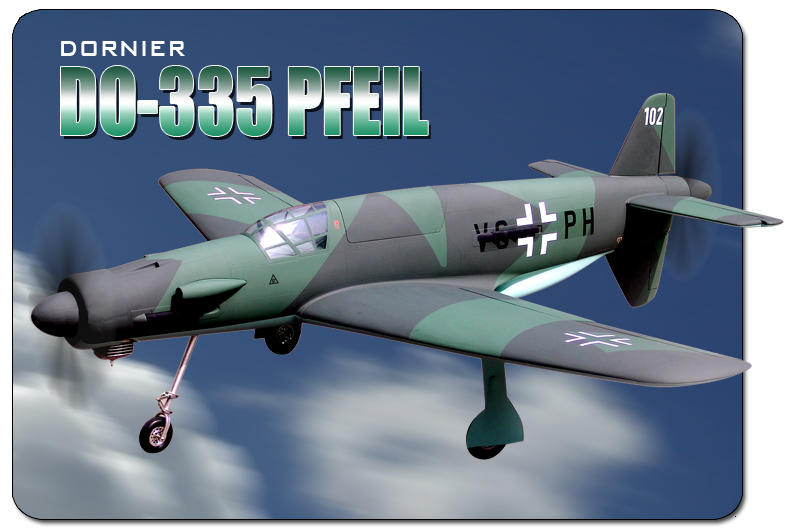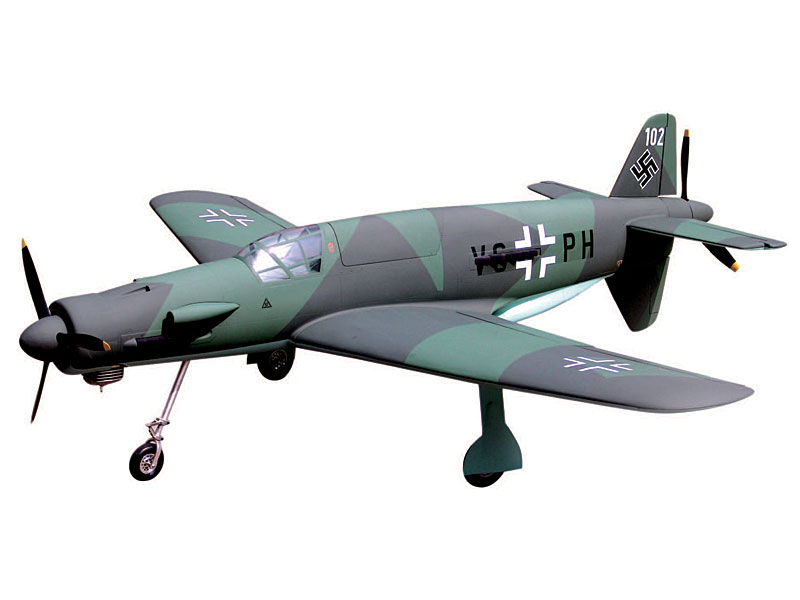Main menu
Specifications:
Length: 2140mm(84.3")
Wing span: 2121mm(83.5")
Wing area: 76.1sq.dm(8.2sq.ft)
Wing loading: 144.5g/sq.dm(47.4oz/sq.ft)
Flying weight: 11kg(24.2lbs)
Radio: 6ch & 11servos(including 4 medium-size servos)
Or 6ch & 13servos(When assemble two engines)
Engine: 50cc gasoline (Factory’s recommendation)
Or one 1.20(front) & one .91(rear).
History:
The Dornier Do 335 Pfeil (or "Arrow") was one of the more unique prop-driven designs of the Second World War. Designed and patented by Doctor Claudius Dornier as early as 1937, the Do 335 utilized a concept in which one engine was mounted forward and another aft on a smooth rounded fuselage with a low-monoplane wing. The front engine would be of a puller-type while the other would be a pusher-type working in conjunction. This design attempt was intended to do away with thrust design flaws enered by single engine fighters of the same class. The result was the Do 335 "Arrow", an aircraft that was powered by two separate engines in a single slim fuselage.
The twin engine design accommodated the pilot in a glazed canopy offering good visibility forward, to the sides and above. A retractable tricycle landing gear was reinforced to accommodate the weight of the airframe and dual engine layout. The landing gear arrangement also made the aircraft to sit rather high when on the ground in an effort to accommodate the clearance of the propeller systems - most notably the rear-mounted one - when the aircraft was taking off. Engines consisted of two Daimler-Benz DB 603 series liquid-cooled 12-cylinder inverted in-line engines. The empennage was dominated by the cruciform tail design which was mounted aft in the fuselage but forward of the rear engine propeller. Armament was 1 x 30mm MG 103 and 2 x 15mm MG 151 cannons and an optional external load of cannon pods, bombs or tanks as needed. The Do 335 recorded speeds upwards of 470 miles per hour with both engines and a respectable 350 miles per hour on a single engine. It's rate-of-climb was about 1,750 feet per minute.
Initially appearing as a research aircraft Goppingen Go 9 in 1939, the system was later put through trials and accepted as a Do P.231 type high-speed bomber. Though development was nearing its final stages, the entire project came to null at that point until later resurrected as a high-speed interceptor when need arose for such a platform. The first Do 335 was first prototyped in no fewer than 14 models in September of 1943 with 10 preproduction models appearing in 1944. The D0 335A-1 became the first of 11 production models and were completed but were never fielded due to the fall of Germany in World War 2 - more specifically, the arrival of US Army elements at the Oberpfaffenhofen factory in April of 1945. The United States Air Force received two Do 335's at the end of the war for testing and further research.
In the event of a required ejection, the tail fin and rear propeller would have had been jettisoned via controlled explosives within the rear fuselage. This would have allowed the pilot to then clear the aircraft from the cockpit at speed without having to worry about any of the aft protrusions endangering his exit.
There were many additional variants planned for the Do 335 airframe that included a twin-seat Do 335A-2 trainer but only two of these designs were ever completed. Additional models proposed were a two-seat night-fighter (Do 435), a long-range reconnaissance model (Do 635) and a fighter model with turbojet propulsion in place of the piston engines (Do 535).
The Do 335 would have a proven quite the adversary had it flown in numbers. The dual-engine layout offered up a top speed to best even that of the famed North American P-51 Mustangs by a considerable margin. Couple that with the firepower of large-caliber cannons and the Do 335 had very little to stand in its way besides the jet age itself. For the one Allied claim of enering an airborne Do 335, the French-piloted Hawker Tempest aircraft was not even able to achieve an effective engagement range to fire on the fleeing Do 335
Similar products
My account
About us
Tel:+30 210 5444 204 Fax: +30 210 5444 384
E-mail: info@diamond-models.gr
Working Hours: M-T-W-T-F from 9:30-20:30 Sat. from 9:30-15:00
Address: Korae 8 & Kapodestreou, Egaleo,Athens,Greece,Zip:122 41















